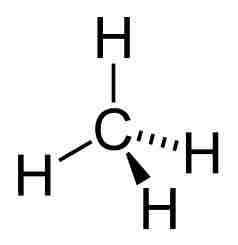Sources of Essential Nutrients for Microorganisms
Nutrients are materials that are acquired from the environment and are used for growth and metabolism. Microorganisms (or microbes) vary significantly in terms of the source, chemical form, and amount of essential elements they need. Some examples of these essential nutrients are carbon, oxygen, hydrogen, phosphorus, and sulfur.
There are two categories of essential nutrients: macro-nutrients (which are needed in large amounts) and micro-nutrients (which are needed in trace or small amounts). Macro-nutrients usually help maintain the cell structure and metabolism. Micro-nutrients help enzyme function and maintain protein structure.
Organic and Inorganic Nutrients
Organic nutrients contain some combination of carbon and hydrogen atoms . Inorganic nutrients are elements or simply molecules that are made of elements other than carbon and hydrogen.

Methane, a simple organic molecule.
Methane is one of the simplest organic molecules.
Essential Nutrients
The sources of common essential nutrients are carbon, hydrogen, nitrogen, oxygen, phosphorus, and sulfur. Organisms usually absorb carbon when it is in its organic form. Carbon in its organic form is usually a product of living things. Another essential nutrient, nitrogen, is part of the structure of protein, DNA, RNA, and ATP. Nitrogen is important for heterotroph survival, but it must first be degraded into basic building blocks, such as amino acids, in order to be used. Oxygen is an important component of both organic and inorganic compounds. It is essential to the metabolism of many organisms. Hydrogen has many important jobs including maintaining the pH of solutions and providing free energy in reactions of respiration. Phosphate is an important player in making nucleic acids and cellular energy transfers. Without sufficient phosphate, an organism will cease to grow. Lastly, sulfur is found in rocks and sediments and is found widely in mineral form.